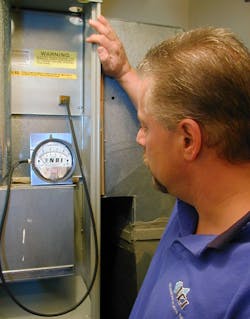Don’t Discard Your Manual Test Instruments Yet!
The other day, I took my 85-year-old mother to her doctor for a routine visit and, after measuring her weight and temperature, the nurse sat her down to measure her blood pressure using a state-of-the-art digital sphygmomanometer (try to pronounce that one!) with all the bells and whistles.
After two tries the nurse was not happy with the unusually high reading, and took Mom over to an old-fashioned analog unit. This required the nurse’s skill to identify and measure her pulse, squeeze a bulb, look at an analog gauge, and “listen” for the correct pressures at which her systolic and diastolic pressures occurred.
If we fall into the trap of not passing down this important knowledge, we could see a generation of technicians completely reliant on computers telling them what to do.
I also learned the correct way to listen is with a stethoscope while the pressure cuff slowly deflates until you hear a heartbeat. That’s your systolic pressure. As the pressure continues to fall, the point at which you can’t hear a heartbeat is your diastolic pressure.
DOWNLOAD AND PRINT ARTICLE FOR YOUR TEAM
It was obvious the nurse had mastered these skills by practicing them many times. It’s likely she was only then allowed to use an electronic meter that does this work for her with little skill required.
As what I had witnessed began to sink in, I transferred this scenario to our industry. Are we becoming too dependent on electronic instruments doing our thinking for us? Now I am not saying we shouldn’t use new digital technology to make the work faster, easier, and most of the time, more accurate.
In fact, I am a huge fan of digital communicating instruments. Nearly a decade ago I wrote an article for this magazine that suggested we should do away with displays and “intelligence” on digital instruments altogether, and build it into applications on your phone so the “instruments” were basically sensors with transmitters. This would make the instruments more durable and less expensive.
What if you’re in the field, an hour away from the office and all you have is a “smart” digital device connected via Bluetooth to your phone, and either your phone runs out of juice or the instrument battery dies, or fails?
It’s exciting to see many instrument manufacturers going exactly in that direction – and I’m a huge fan of these new toys . . . I mean tools!
But technology advancements aside, I think we still need to teach our technicians the basics, including how manual instruments work and how to use them in the absence of their electronic descendants for two main reasons:
1. A deeper understanding of what’s being measured. When you understand how an instrument works, you develop the skills and knowledge to interpret what it is reading. You’ll know when you are getting a false reading and why. When you learn the mechanics of pressure, for example, understanding how a liquid-filled manometer works, and how a tenth of an inch of water column actually means moving a column of water a tenth of an inch, you develop a deeper understanding of what you are measuring and what it means.
We shouldn’t lose track of learning what the instruments are physically measuring and how — and what the readings truly mean.
If we fall into the trap of not passing down this important knowledge and skillset, we could see a generation of technicians completely reliant on computers telling them what’s going on, and perhaps what they should do about it. In this scenario, if the digital interpretation is incorrect, the technician may not have enough understanding of why, and when to second guess the readings.
2. It’s a good idea to have some manual backups – just in case. Virtually all airplane cockpits still have analog gauges sitting right next to their digital readouts and computer screens. There’s an industry that understands the value of manual backup! And all pilots are required to know how to read analog instruments to get their license.
What if you’re in the field, an hour away from the office and all you have is a “smart” digital device connected via Bluetooth to your phone, and either your phone runs out of juice or the instrument battery dies or it fails? Wouldn’t it be great if you could pull out an analog device and get your measurements anyway?
For example, an analog manometer with a pressure tip and a pitot tube can measure static pressure, velocity pressure, air velocity and more, without relying on batteries or a digital meter. Analog volt/ammeters are still sold today, and could do the trick if your digital meter is on the fritz. Dial type thermometers can also work fine in a pinch. You get the idea.
To be sure, I’m not at all suggesting we go backwards to archaic technologies and live in caves. The point is we shouldn’t lose track of learning what the instruments are physically measuring and how - and what the readings truly mean. This will continue to help differentiate great technicians from the parts changers and hacks out there, and help pass forward this knowledge to future generations of HVAC professionals.
Dominick Guarino is CEO of National Comfort Institute (NCI), (www.nationalcomfortinstitute.com), one of the nation’s premier Performance-BasedTM training, certification, and membership organizations, focused on helping contractors grow and become more profitable. His e-mail is [email protected]. For more info on Performance-Based Contracting™, go to WhyPBC.com or call NCI at 800/633-7058.
About the Author
Dominick Guarino
Chief Executive Officer
Dominick Guarino is CEO of National Comfort Institute (NCI), (www.nationalcomfortinstitute.com), the nation’s premier Performance-Based training,
certification, and membership organization, focused on helping contractors grow and become more profitable. His email is [email protected]. For more info on performance-based contracting, go to WhyPBC.com or call NCI at 800/633-7058.
